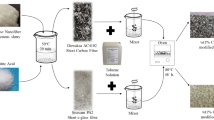Abstract
The fracture toughness of Kevlar-epoxy resin composites with intermittent fibre bonding of a silicone vacuum fluid (SVF-200) and a polyurethane varnish (Estapol 7008) have been studied over the temperature range −60 to 40° C and strain rates 0.03 to 5000 min−1. Whilst both coating materials give similar tensile strengths their effects on toughness are very different. As far as toughening is concerned Estapol 7008 is more effective than SVF-200. The toughening effect increases with increasing intermittent lengths of the Estapol-7008 coating, i.e. coating parameterC, increasing temperature and decreasing strain rate. At low strain rates and high temperatures, forC=1, the toughness increase is some 200 to 300% compared to the uncoated composites. Some initial work has also been conducted for hygrothermally aged uncoated and coated fibre composites. The SVF-200 coated composites do not show any toughness degradation compared to the dry control samples. However, both the uncoated and Estapol-7008 coated composites suffer some toughness loss. Even so, the toughness of the fully coated aged specimens is as good as the uncoated dry controls. A fracture analysis is presented which gives reasonable agreement between predicted fracture toughness values and experimental measurements. It is shown that fibre pull-out toughness and fibre fracture work are the main contributors to the total fracture toughness of these fibre composites; their relative significance being dependent on the type of coating material, the temperature and strain rate of testing.
Similar content being viewed by others
References
T. U. Marston, A. G. Atkins andD. K. Felbeck,J. Mater. Sci. 9 (1974) 447.
A. G. Atkins,ibid. 10 (1975) 819.
J. Cook andJ. E. Gordon,Proc. Roy. Soc. A282 (1964) 508.
N. L. Hancox andH. Wells,Fibre Sci. Technol. 10 (1977) 9.
N. H. Sung, T. J. Jones andN. P. Suh,J. Mater. Sci. 12 (1977) 239.
J. G. Morley andR. S. Millman,ibid. 9 (1974) 1171.
J. G. Morley andJ. R. McColl,J. Phys. D: Appl. Phys. 8 (1975) 15.
G. A. Cooper andM. R. Piggott, “Cracking and fracture in composites”, in Fracture 1977, Vol. 1 (ICF4, 1977) pp. 557–605.
J. P. Favre,J. Mater. Sci. 12 (1977) 43.
L. C. Jea andD. K. Felbeck,J. Compos. Mater. 14 (1980) 245.
Y. W. Mai, B. Cotterell andR. Lord, “On fibre composites with intermittent interlaminar bonding”, in progress in Science and Engineering of Composites, Vol. 1, edited by T. Hayashiet al. (ICCM-IV, Tokyo, 1982) pp. 271–277.
Y. W. Mai, M. I. Hakeem andB. Cotterell,Cem. Conc. Res. 12 (1982) 661.
F. Castino, M. Eng. Sc. Thesis, Sydney University, Sydney, Australia (1983).
D. H. Napper, Private communication, (February 1983).
P. C. Hermann, B. E. Thesis, Department of Mechanical Engineering, University of Sydney, Sydney, Australia (1982).
A. G. Atkins andY. W. Mai,J. Mater. Sci. 11 (1976) 2297.
M. Fuwa, D. Phil. Thesis, University of Sussex, England (1974).
A. R. Bunsell,J. Mater. Sci. 10 (1975) 1300.
A. Kelly,Proc. Roy. Soc. (London) A319 (1970) 95.
M. R. Piggott,J. Mater. Sci. 5 (1970) 669.
P. W. R. Beaumont, J. Fitz-Randolph, D. C. Phillips andA. S. Teleman,J. Compos. Mater. 5 (1971) 542. (See alsoJ. Mater. Sci. 7 (1972) 289).
A. H. Cottrell,Proc. Roy. Soc. London A282 (1964) 2.
A. Kelly, in “Strong Solids” (Oxford University Press, 1966).
Author information
Authors and Affiliations
Rights and permissions
About this article
Cite this article
Mai, Y.W., Castino, F. Fracture toughness of Kevlar-epoxy composites with controlled interfacial bonding. J Mater Sci 19, 1638–1655 (1984). https://doi.org/10.1007/BF00563062
Received:
Accepted:
Issue Date:
DOI: https://doi.org/10.1007/BF00563062




